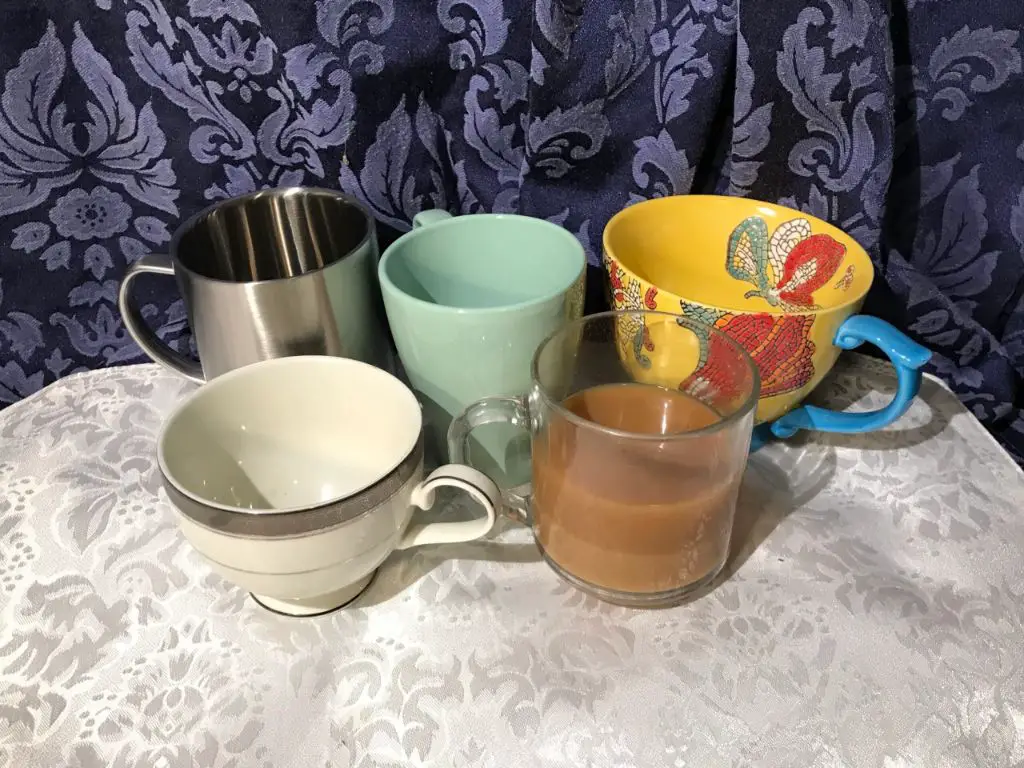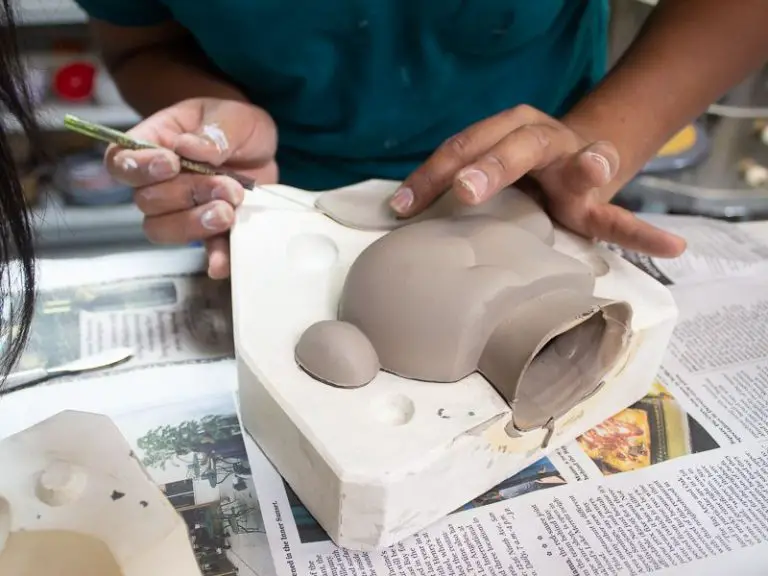Can You Drink Out Of A Glazed Clay Mug?
Glazed clay mugs have been used for thousands of years as a functional and decorative drinking vessel. The glazing process seals the porous clay, making the mug non-absorbent and watertight. This allows hot or cold liquids to be safely contained. Glazed mugs are oven, microwave, and dishwasher safe. They are valued for their durability, craftsmanship, artistry, and variety of colors and designs.
Glazed clay mugs are still commonly handmade by artisan potters and ceramicists around the world. They are ubiquitous tableware, beloved for daily use or special occasions. Their pleasing heft and heat retention enhances the drinking experience. Glazed mugs can be customized with monograms and designs and given as meaningful gifts.
Glaze Composition
Glazes are made up of three main ingredients: clay, fluxes, and colorants 1. The clay, commonly silica, provides the glaze structure and stability. Fluxes, such as feldspar, lower the melting point of the glaze so it vitrifies at kiln temperatures. Colorants like metal oxides add color and desired effects. A balanced glaze recipe requires the right proportions of these components.
The clay portion, usually 20-30%, is often potassium or soda feldspar, nepheline syenite, or silica. These provide the glaze backbone. Fluxes (50-70%) melt the glaze and allow it to flow smoothly, commonly sodium, potassium, calcium, magnesium, or boron compounds. Colorants (1-10%) like cobalt, copper, iron, or manganese oxides add color. Recipes must be precisely balanced to achieve the desired glaze effects.
Glazes vitrify during firing as the clay, fluxes, and colorants combine at high temperatures. The fluxes lower the melting point so the glaze flows smoothly. The ratios of ingredients determine glaze properties like color, texture, and visual effects. Skillful glaze formulation creates vibrant, functional glazes.
FDA Regulations
The FDA regulates lead levels in ceramics, including glazed mugs, to ensure they are safe for food and beverage use. According to FDA guidance, ceramicware should not leach more than 3 parts per million (ppm) of lead during use.
To test lead levels, manufacturers perform lead leach testing on ceramicware. This involves filling the ceramic with 4% acetic acid for 24 hours to simulate the leaching effect of acidic foods and beverages. The leachate is then analyzed to determine the ppm of lead released.
Any ceramic that leaches more than 3 ppm of lead fails to meet FDA standards. Per the FDA’s Compliance Policy Guide Sec. 545.450, imported ceramics that fail leach testing may be subject to detention and refusal of entry into the U.S. [1]
Lead Concerns
One of the main concerns with drinking from glazed clay mugs is the potential for lead to leach from the glaze into the food or drink. Lead is a toxic heavy metal that can cause health problems even at low levels of exposure. Glazes often contain lead, which can dissolve into acidic liquids like coffee, tea, juice or alcohol (Anderson, 2017).
Studies have found that lead can leach from ceramic mugs into hot drinks at detectable levels. One study tested ceramic mugs purchased in the European Union market and found lead release in 30% of samples, though generally below regulatory limits (Rebeniak et al., 2014). Another small study found concerning lead levels in some coffee samples prepared in ceramic mugs (Anderson, 2017).
Factors that affect lead leaching include the glaze composition, pH of the food or drink, temperature, and length of contact. More research is still needed on the levels of lead exposure from ceramic drinkware under typical usage conditions.
Other Safety Concerns
In addition to lead, other heavy metals like cadmium and arsenic may also leach from ceramic glazes into food and drink. Cadmium in particular is known to be toxic and a carcinogen. Older glaze recipes were more likely to contain cadmium, but it may still be present in some modern glazes, especially bright colors like yellow, orange, and red.

Cadmium and arsenic can leach into food and drink when the glaze isn’t properly fused to the clay body, allowing the metals to leach through microfissures. Acidic foods and drinks in particular will draw metals out of the glaze. Proper firing to maturity and using high quality well-tested glazes is important to prevent leaching of dangerous metals like cadmium and arsenic.
Many countries have regulations limiting the amount of toxic metals like cadmium permitted in ceramic wares intended for food use. In the US, tolerances range from 0.25-0.5 mcg of cadmium per ml of leaching solution depending on the type of ceramic ware (Digitalfire). Reputable manufacturers will have their glazes tested to ensure they are within safety limits.
Proper Use
To get the most use and enjoyment out of your glazed clay mug, follow these proper care recommendations:
Handwashing is ideal. Wash the mug by hand using warm water and mild dish soap. Avoid extremely hot water which can cause crazing (fine cracks). Let the mug air dry completely before use.
Avoid putting the mug in the dishwasher, as high heat and harsh detergents can damage the mug over time. The abrupt temperature changes in a dishwasher can also lead to crazing.
Don’t use the mug for hot liquids like boiling water or tea/coffee immediately off the stove. Let liquids cool slightly first to prevent thermal shock cracking. Also avoid freezing liquids in the mug.
Don’t use acidic liquids like juice, wine or vinegar which can erode the glaze over time. Stick to water and low-acidity drinks.
Handle the mug gently and don’t drop it. Glazed clay, while durable, can chip or crack if subjected to hard impacts.
With proper care and handling, a glazed clay mug can provide years of beauty and enjoyable use. Refer to the manufacturer’s care instructions for any specific recommendations.
Quality Manufacturing
Well-made glazed clay mugs that follow proper manufacturing guidelines are generally considered safe for regular use. Reputable mug manufacturers in the US adhere to FDA regulations and avoid using concerning levels of lead in glazes. They also use high-quality clay and glazes that withstand regular washing without leaching chemicals.
When shopping for glazed clay mugs, look for those made in the US by established artists and brands. Deneen Pottery, East Fork, and Clay in Motion are examples of companies known for their durable, lead-free mugs made from quality materials (East Fork). Their mugs are generally microwave and dishwasher safe. Well-crafted clay mugs should not leach harmful chemicals into beverages when used properly.
The key is finding a properly made mug from a reputable source. With quality manufacturing and materials, glazed clay mugs can be a safe, durable, and beautiful option for daily use.
Alternatives to Ceramic Mugs
While ceramic mugs are generally considered safe for drinking, some people may prefer to avoid them due to concerns over lead exposure. There are several excellent alternative mug materials to consider:
Glass
Glass mugs and cups provide an inert, nonporous surface that does not react with foods or beverages. They are lead-free and safe for daily use. Glass withstands very high temperatures and is durable with proper care. However, glass can break if dropped. The thick walls of high quality glass mugs make them quite sturdy for regular use.
Stainless Steel
Stainless steel is an excellent non-porous mug material that does not react with beverages or foods. High quality stainless steel mugs are durable, shatter-resistant, and easy to clean. Stainless steel does not contain lead. Make sure any insulating plastic or silicone covers are BPA-free. Some stainless steel mugs have double-walled vacuum insulation to maintain temperatures.
The Verdict
Glazed clay mugs are generally considered safe to drink from, as long as they are produced by reputable manufacturers using proper materials and firing techniques. The glaze seals the clay so that no lead or toxic materials leach into liquids. However, it’s still smart to take precautions:
- Avoid old or antique pottery, as glazes were less regulated in the past.
- Inspect mugs to ensure the glaze is smooth and free of cracks, crazing, or worn spots.
- Wash new mugs before first use to remove any residue.
- Don’t let liquids sit in mugs for extended periods, especially acidic drinks which can erode the glaze over time.
- Avoid highly leaded glazes or porous clay bodies. Reputable brands test their wares for safety.
As long as you choose high-quality, lead-free glazed mugs from trustworthy brands and handle them with care, there is minimal risk in enjoying your favorite hot or cold beverage in a beautiful ceramic vessel.
References
[1] Food and Drug Administration. Lead in Food, Foodwares, and Dietary Supplements. https://www.fda.gov/food/metals-and-your-food/lead-food-foodwares-and-dietary-supplements
[2] Environmental Protection Agency. Basic Information about Lead in Drinking Water. https://www.epa.gov/ground-water-and-drinking-water/basic-information-about-lead-drinking-water
[3] Centers for Disease Control and Prevention. Lead. https://www.cdc.gov/nceh/lead/
[4] Clay Times Magazine. An Introduction to Clay and Glaze Chemistry. https://claytimes.com/guide-to-clay-body-and-glaze-chemistry/introduction-clay-glaze-chemistry.html
[5] The Spruce Eats. Are Coffee Mugs Safe to Use? https://www.thespruceeats.com/are-coffee-mugs-safe-to-use-766320

